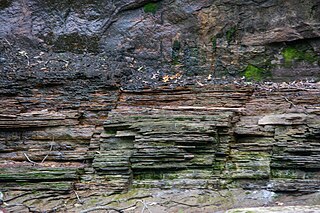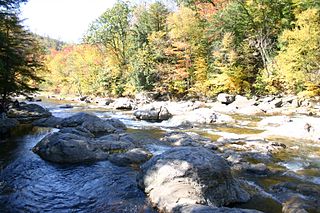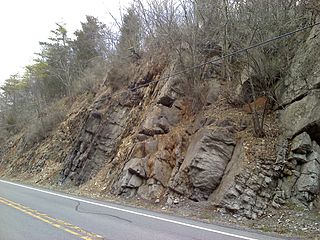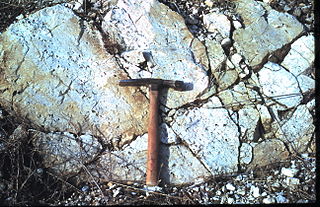 W
WThe Bakken Formation is a rock unit from the Late Devonian to Early Mississippian age occupying about 200,000 square miles (520,000 km2) of the subsurface of the Williston Basin, underlying parts of Montana, North Dakota, Saskatchewan and Manitoba. The formation was initially described by geologist J.W. Nordquist in 1953. The formation is entirely in the subsurface, and has no surface outcrop. It is named after Henry Bakken, a farmer in Tioga, North Dakota, who owned the land where the formation was initially discovered while drilling for oil.
 W
WThe Becraft Formation is a geologic formation of marine sedimentary rock found in New York State. The Becraft is a part of the lower Devonian Helderberg Group and conformably overlies the New Scotland Formation and is overlain by the Alsen Formation throughout the lower Hudson Valley of New York State. The formation is Gedinnian in age. Outcrops of the formation are found from the New York-New Jersey border to the Helderbergs of Albany County, New York and as far west as Schoharie County, New York. The thickness of the formation varies from around 3 meters in Canajoharie to 8 meters thick in Albany and swells to 27 meters near Kingston. The Becraft Formation is named for Becraft Mountain in western Columbia County, New York where it prominently crops out.
 W
WThe Bedford Shale is a shale geologic formation in the states of Ohio, Michigan, Pennsylvania, Kentucky, West Virginia, and Virginia in the United States.
 W
WThe Devonian Brallier Formation is a mapped bedrock unit in Pennsylvania, Maryland, West Virginia, and Virginia.
 W
WThe Devonian Catskill Formation or the Catskill Clastic wedge is a unit of mostly terrestrial sedimentary rock found in Pennsylvania and New York. Minor marine layers exist in this thick rock unit. It is equivalent to the Hampshire Formation of Maryland, West Virginia, and Virginia.
 W
WThe Chattanooga Shale is a geologic formation in Alabama, Arkansas, Kentucky, Missouri and Tennessee. It preserves conodont fossils dating to the Devonian Period. It occurs mostly as a subsurface geologic formation composed of layers of shale. It is located in Eastern Tennessee and also extends into southeastern Kentucky, northeastern Georgia, and northern Alabama. This part of Alabama is part of the Black Warrior Basin.
 W
WThe Cleveland Shale, also referred to as the Cleveland Member, is a shale geologic formation in the eastern United States.
 W
WThe Duvernay Formation is a stratigraphical unit of Frasnian age in the Western Canadian Sedimentary Basin.
 W
WThe Horn River Formation is a stratigraphic unit of Devonian age in the Western Canadian Sedimentary Basin.
 W
WThe Huntley Mountain Formation is a late Devonian and early Mississippian mapped bedrock unit in Pennsylvania, in the United States.
 W
WThe Devonian Jeffersonville Limestone is a mapped bedrock unit in Indiana and Kentucky. It is highly fossiliferous.
 W
WThe Late Silurian to Early Devonian Keyser Formation is a mapped limestone bedrock unit in Pennsylvania, Maryland, Virginia, and West Virginia.
 W
WThe Marcellus Formation or the Marcellus Shale is a Middle Devonian age unit of sedimentary rock found in eastern North America. Named for a distinctive outcrop near the village of Marcellus, New York, in the United States, it extends throughout much of the Appalachian Basin.
 W
WThe Marcellus Formation or the Marcellus Shale is a Middle Devonian age unit of sedimentary rock found in eastern North America. Named for a distinctive outcrop near the village of Marcellus, New York, in the United States, it extends throughout much of the Appalachian Basin.
 W
WThe Muskwa Formation is a stratigraphical unit of Frasnian age in the Western Canadian Sedimentary Basin.
 W
WThe Devonian Old Port Formation is a mapped bedrock unit in Pennsylvania, USA. Details of the type section and of stratigraphic nomenclature for this unit as used by the U.S. Geological Survey are available on-line at the National Geologic Map Database. Current nomenclature usage by U.S. Geological Survey restricts the name Old Port Formation to Pennsylvania, but correlative units are present in adjacent states.
 W
WThe Old Red Sandstone is an assemblage of rocks in the North Atlantic region largely of Devonian age. It extends in the east across Great Britain, Ireland and Norway, and in the west along the northeastern seaboard of North America. It also extends northwards into Greenland and Svalbard. These areas were a part of the ancient continent of Euramerica/Laurussia. In Britain it is a lithostratigraphic unit to which stratigraphers accord supergroup status and which is of considerable importance to early paleontology. For convenience the short version of the term, ORS is often used in literature on the subject. The term was coined to distinguish the sequence from the younger New Red Sandstone which also occurs widely throughout Britain.
 W
WThe Rockwell Formation is a late Devonian and early Mississippian mapped bedrock unit in West Virginia, Maryland, and Pennsylvania, in the United States.
 W
WThe Devonian Temple Butte Formation, also called Temple Butte Limestone, outcrops through most of the Grand Canyon of Arizona, USA; it also occurs in southeast Nevada. Within the eastern Grand Canyon, it consists of thin, discontinuous and relatively inconspicuous lenses that fill paleovalleys cut into the underlying Muav Limestone. Within these paleovalleys, it at most, is only about 100 feet (30 m) thick at its maximum. Within the central and western Grand Canyon, the exposures are continuous. However, they tend to merge with cliffs of the much thicker and overlying Redwall Limestone.
 W
WThe Yahatinda Formation is a geologic formation of Middle Devonian (Givetian) age in the southwestern part of the Western Canada Sedimentary Basin in the mountains of southwestern Alberta. Its type locality lies the on the eastern face of Wapiti Mountain above Ya-Ha-Tinda Ranch at the eastern edge of Banff National Park. The Yahatinda contains a variety of Devonian fossils.